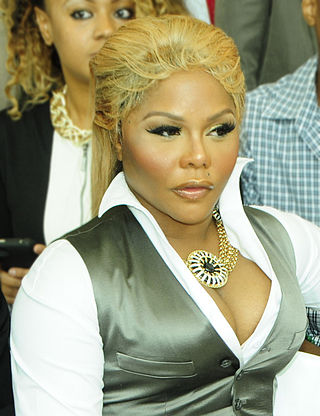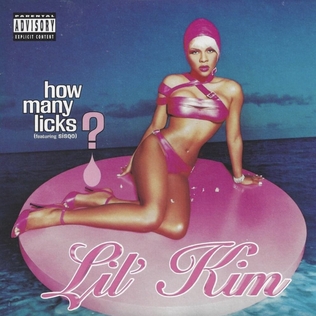
Kimberly Denise Jones, better known by her stage name Lil' Kim, is an American rapper. She was born and raised in New York City and lived much of her adolescent life on the streets after being expelled from home. In her teens, she would freestyle rap, influenced by fellow female hip-hop artists like MC Lyte and the Lady of Rage. In 1994, she was discovered by fellow rapper The Notorious B.I.G., who invited her to join his group Junior M.A.F.I.A.; their debut album, Conspiracy, generated two top 20 singles in the United States and was certified gold by the Recording Industry Association of America (RIAA).
Karrine Steffans, also known as Elisabeth Ovesen, is an American author, most notably of the Vixen series of books. She has worked as an actress and as a video vixen, having appeared in more than 20 music videos. In 2007 and 2008, Steffans visited a number of college campuses to speak about her involvement in the hip hop industry and its expectations of women.
Sexualization is the emphasis of the sexual nature of a behavior or person. Sexualization is linked to sexual objectification, treating a person solely as an object of sexual desire. According to the American Psychological Association, sexualization occurs when "individuals are regarded as sex objects and evaluated in terms of their physical characteristics and sexiness." "In study after study, findings have indicated that women more often than men are portrayed in a sexual manner and are objectified. In addition, a narrow standard of physical beauty is heavily emphasized. These are the models of femininity presented for young girls to study and emulate."

"How Many Licks?" is a song by American rapper Lil' Kim featuring vocals by American musician Sisqó from Lil' Kim's second studio album, The Notorious K.I.M. (2000). Mario Winans and Sean Combs produced the song, and wrote it with Lil' Kim and Sisqó. The hip hop song samples the Knight Rider theme song, with lyrics expressing a woman's desire for oral sex and her sexual relationships with a variety of men. The chorus is a reference to the advertising slogan for Tootsie Pops. A remix by the Neptunes has additional vocals from American artists Kelis, Lil' Cease, and Snoop Dogg. "How Many Licks?" was released as the second and final single from The Notorious K.I.M. on November 21, 2000, by Queen Bee Entertainment and Atlantic Records.

Stereotypes of African Americans are misleading beliefs about the culture of people with partial or total ancestry from any black racial groups of Africa whose ancestors resided in the United States since before 1865, largely connected to the racism and the discrimination to which African Americans are subjected. These beliefs date back to the slavery of black people during the colonial era and they have evolved within American society.

"Wouldn't Get Far" is the third single from The Game's second album Doctor's Advocate. The song, produced by and featuring Kanye West, is about The Game mentioning and criticizing, by both name and alias, up-and-coming and established video vixens, models and actresses. The song peaked at number 64 on the Billboard Hot 100 chart and reached numbers 11 and 26 on the Billboard Hot Rap Songs and Hot R&B/Hip-Hop Songs charts respectively.

Confessions of a Video Vixen is a memoir written by Karrine Steffans which details the first 25 years of her life. Part tell-all covering her sexual liaisons with music industry personalities and professional athletes, and part cautionary tale about the dangers of the otherwise romanticized hip-hop music industry, it caused considerable controversy in some circles.

Onika Tanya Maraj-Petty, known professionally as Nicki Minaj, is a Trinidadian-born rapper and singer based in the United States. Often referred to as the "Queen of Rap", she is known for her musical versatility, animated rap flow, and alter egos. She first gained recognition after releasing three mixtapes between 2007 and 2009.

Sexuality in music videos has been evident since the 1980s.
Misogyny in rap music refers to lyrics, videos, or other aspects of rap music that support, glorify, justify, or normalize the objectification, exploitation, or victimization of women. It is an ideology that portrays women as objects for men's ownership, use, or abuse. It diminishes women to expendable beings. It can range from innuendoes to stereotypical characterizations and defamations.

"The Boys" is a song by rapper Nicki Minaj and American singer Cassie. It was released on September 13, 2012 by Young Money, Cash Money and Universal Republic as the lead single from the reissue of Minaj's second studio album, Pink Friday: Roman Reloaded – The Re-Up (2012). It was written by Minaj, Anjulie Persaud, Jonas Jeberg and Jean Baptiste, and produced by the latter two. It was Minaj's last single to be released by Universal Republic before the label went defunct and its artists roster moved to the revived Republic Records. Initially a track recorded by Cassie for her second studio album under the title "Money on Love," it was subsequently played for Minaj during sessions for The Re-Up, who decided to keep Cassie's vocals but wrote her own verses with certain production portions also being re-worked.
The angry black woman stereotype is a racial stereotype of Black American women as pugnacious, poorly mannered, and aggressive.
Hip hop feminism is a sub-set of black feminism that centers on intersectional subject positions involving race and gender in a way that acknowledges the contradictions in being a black feminist, such as black women's enjoyment in hip hop music and culture, rather than simply focusing on the victimization of black women in hip hop culture due to interlocking systems of oppressions involving race, class, and gender.
Misogynoir is a term referring to misogyny directed towards black women where race and gender both play a role. The term was coined by black feminist writer Moya Bailey in 2008 to address misogyny directed toward black transgender and cisgender women in American visual and popular culture. The concept of misogynoir is grounded in the theory of intersectionality, which analyzes how various social identities such as race, gender, class, age, ability, and sexual orientation interrelate in systems of oppression.
In hip hop, the term mami refers to an attractive Latina woman, typically of Puerto Rican or Dominican descent. There is also the emergence of the mami video vixen, who is the glamorized, hyper-sexualized version of an attractive Latina woman that is seen in rap videos. The image of mami that is the most popular in rap culture is the butta pecan mami, a term coined by Raquel Z. Rivera, which refers to a Latina woman who has light golden colored skin and "good" (European-type) hair.

Wanda Ewing (1970–2013) was an artist born in Omaha, Nebraska. She considered her art to be "provocative with a political edge." A common message of her art was “I’m a proud black woman, and I’m going to be hard to ignore.” Ewing studied printmaking at San Francisco Art Institute where she received her BFA in 1997. She received her MA and MFA in printmaking at the University of Iowa in 2001 and 2002, respectively. She was a tenured professor at the University of Nebraska at Omaha, where she taught visual arts classes from 2004 to 2013. Ewing exhibited nationally and won several awards for her work.
Feminist activism in hip hop is a feminist movement based by hip hop artists. The activism movement involves doing work in graffiti, break dancing, and hip hop music. Hip hop has a history of being a genre that sexually objectifies and disrespects women ranging from the usage of video vixens to explicit rap lyrics. Within the subcultures of graffiti and breakdancing, sexism is more evident through the lack of representation of women participants. In a genre notorious for its sexualization of women, feminist groups and individual artists who identify as feminists have sought to change the perception and commodification of women in hip hop. This is also rooted in cultural implications of misogyny in rap music.
Raunch aesthetics is a term in feminist theory which describes the ways in which women in hip hop express their sexuality through the performance of lyrics, choreography, and staging. These aesthetics are performed by artists such as Rihanna, Beyoncé, Ciara, Nicki Minaj, Megan Thee Stallion and Miley Cyrus with the intention to embrace and take control over their own bodies and sexual identities through verbal and physical expression.
The lack of respect that black women received in the music industry gave rise to hip-hop feminism, as singers such as Monie Love brought attention to the differences in acknowledgment that exist even for equal talent. The movement tackles problems arising from deindustrialization, racial wealth disparities, and conservative backlash. It was molded by the social environment of the 1980s and 1990s. Me'Shell Ndegeocello an American rapper, singer and bassist and Angie Stone a singer are two artists that have shaped the conversation. Hip-hop feminism goes beyond gender issues to support the rights of women, African Americans, and LGBTQ+ people. Prominent figure in the genre Queen Latifah used "the politics of respectability" to promote women's rights and racial empowerment. Ndegeocello is one of the rising queer feminists of color who brings a nuanced viewpoint to problems like abortion and unjust beauty standards. Changes in perspectives are reflected in the transition from male-dominated hip-hop to women-centered hip-hop soul, which allows for a diversity of narratives within black communities. The Grammy-winning song "U.N.I.T.Y." by Queen Latifah was a historic moment that validated the powerful voice of black women in a male-dominated field and sparked discussions about domestic abuse and the commodification of black women's sexuality. In the United States, the introduction of new styles of music came during the Transatlantic Slave Trade era. The genres of music include, but are not limited to, blues, rock, gospel music, jazz, bluegrass, and Hip-hop. African American women in the music industry have made significant contributions over the years.

"Super Freaky Girl" is a song by Trinidadian-born rapper Nicki Minaj from her fifth studio album, Pink Friday 2 (2023). It was released on August 12, 2022, by Young Money Entertainment and Republic Records as the lead single from the album. It is an upbeat, raunchy song that samples Rick James' 1981 single "Super Freak," as Minaj raps about a girl having sexual fantasies and endeavors, while also boasting about her career. It received comparisons to Minaj's 2014 single "Anaconda," as both tracks include classic samples and sexual lyrics.










